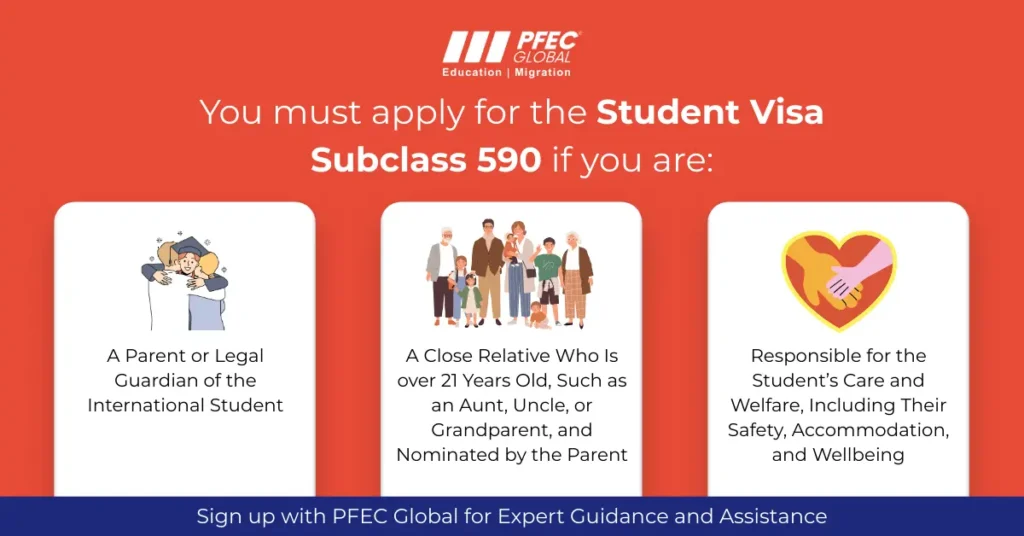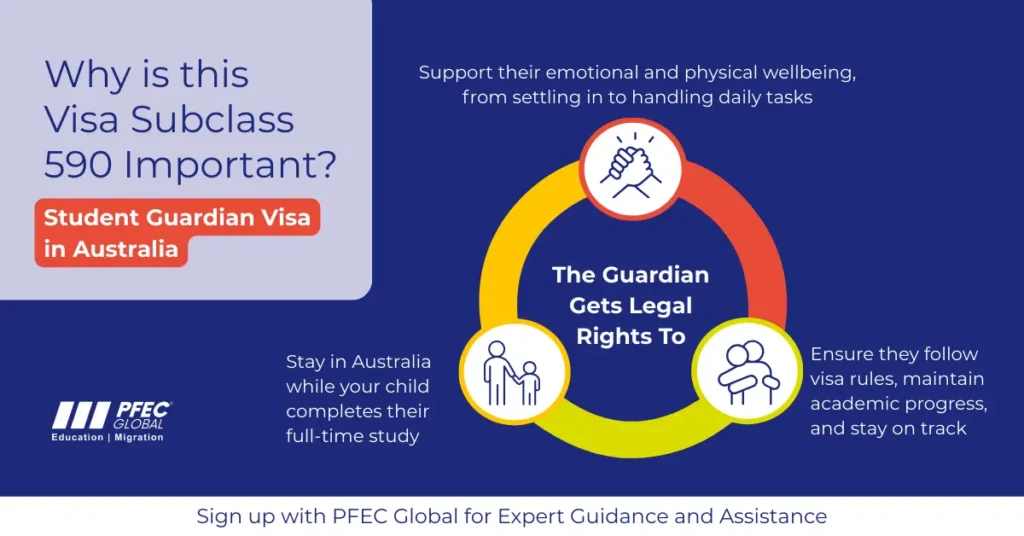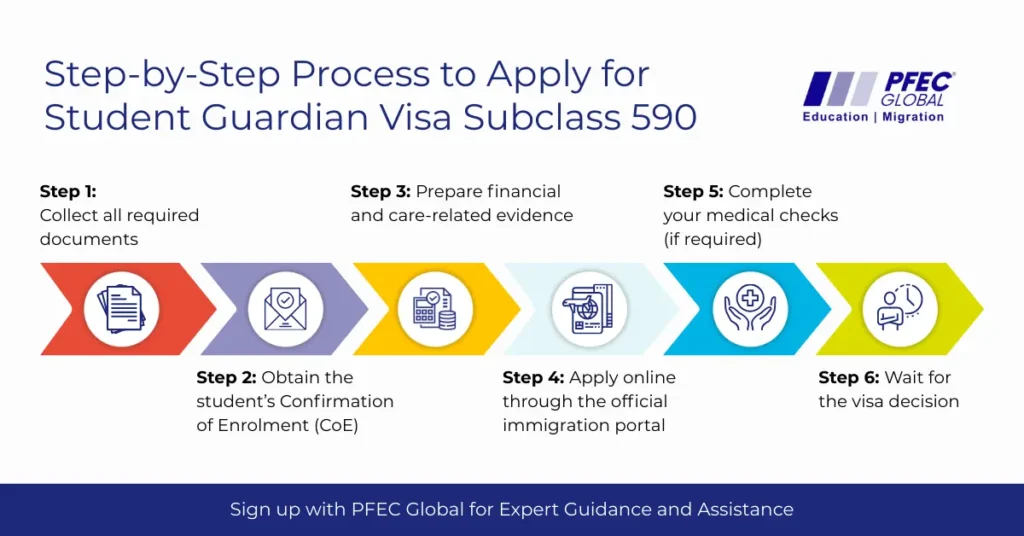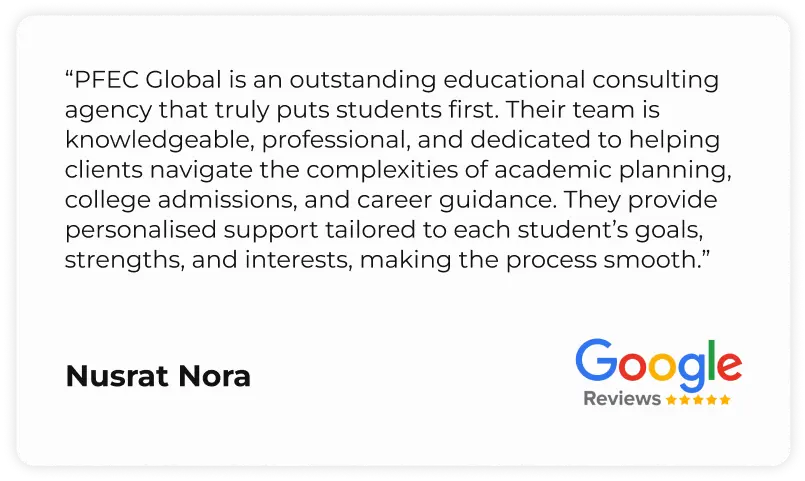Student Guardian Visa Subclass 590

Health insurance is an essential requirement for a worry-free experience while studying abroad.
International Medical Coverage: Health insurance provides you with the peace of mind to receive medical care anywhere in the world, ensuring you won't face overwhelming expenses.
Visa and Enrollment Support:Having health insurance can make obtaining a student visa and enrollment easier. This reduces the chances of your applications being delayed or rejected.
Financial Protection: In the event of an unexpected incident, having health insurance ensures that your medical expenses are covered. It safeguards you from potential financial stress.
Legal Compliance: Many countries create specific health insurance for international students. Securing this insurance not only safeguards your well-being but also shields you from potential legal complications and the risk of deportation. Protect yourself and ensure a smooth study experience abroad.
Comprehensive Care: Health insurance covers expenses related to hospital stays, prescription medications, mental health support, and much more.
Register with Us to Take the Next Step
Country-wise rules
The USA has a unique system that students must navigate to meet certain criteria. In contrast, Australia requires international students to have Overseas Student Health Cover (OSHC). Similarly, in the UK, students are obligated to pay an Immigration Health Surcharge (IHS) to gain access to the National Health Service (NHS). Additionally, some universities have their own specific requirements, which often include particular coverage limits in their health insurance schemes.
Selecting a plan
Recognizing the diverse needs of students, universities create customized health insurance policies that provide essential coverage. Students can conveniently enroll in these plans during their registration process, ensuring peace of mind from day one. If a university does not offer its own insurance, students must seek private health insurance, which may not fully meet their specific needs. It's crucial for universities to invest in comprehensive health insurance options that prioritize student well-being and security.
Purchasing Health Insurance
Health insurance is essential for students, and selecting the right plan is vital for their well-being. By carefully considering their unique needs, students can find a plan that offers the best balance of cost and benefits. After choosing a suitable plan and making the necessary payment, students will receive a certificate as proof of their coverage, ensuring assurance during their academic journey.
Country-wise rules
The USA has a unique system that students must navigate to meet certain criteria. In contrast, Australia requires international students to have Overseas Student Health Cover (OSHC). Similarly, in the UK, students are obligated to pay an Immigration Health Surcharge (IHS) to gain access to the National Health Service (NHS). Additionally, some universities have their own specific requirements, which often include particular coverage limits in their health insurance schemes.
Country-wise rules
The USA has a unique system that students must navigate to meet certain criteria. In contrast, Australia requires international students to have Overseas Student Health Cover (OSHC). Similarly, in the UK, students are obligated to pay an Immigration Health Surcharge (IHS) to gain access to the National Health Service (NHS). Additionally, some universities have their own specific requirements, which often include particular coverage limits in their health insurance schemes.
Student Guardian Visa Subclass 590 – A Simple Guide for Parents
When your child is studying in Australia, it’s natural to want to stay close and support them—especially if they’re under 18. The Student Guardian Visa Subclass 590 allows a parent, legal guardian, or close relative already in Australia to care for an international student full-time.
This visa ensures your child has the emotional and practical support they need during their education, while also giving you legal permission to live with them here.
What Is the Student Guardian Visa Subclass 590?

The Subclass 590 visa is a temporary visa for family members who need to live in Australia to care for a student visa holder. It’s usually required if the student is under 18, or if there are exceptional circumstances where a student over 18 needs ongoing support.
You must be fully involved in the student’s welfare, including their safety, accommodation, and day-to-day support.
Who Can Apply?
You may be eligible if you are:
- The parent or legal guardian of the student
- A nominated close relative (e.g. aunt, uncle, or grandparent) over 21 years old
- Living in Australia on an eligible substantive visa (if applying onshore)
- Committed to supporting the student’s welfare in Australia
Expert Tip: Students under 18 cannot remain in Australia without approved welfare arrangements. This visa fulfills that requirement.
When Is This Visa Required?
You must apply for the Student Guardian Visa if:
- The student is under 18 years old, or
- They are over 18 but need special care due to health, emotional, or personal reasons
This is not a discretionary visa—it is a requirement for minors under Australian student visa conditions.
When is it needed?

Holding a guardian visa for Australia means you can:
- Stay legally in Australia while your child completes their studies
- Provide daily care and emotional support during a crucial transition
- Help ensure they follow Subclass 590 visa conditions, such as maintaining academic performance and visa compliance
You are not allowed to work on this visa, and your primary role must be to care for the student. Short study (e.g., English courses under 20 hours/week) is permitted, but working is not.
Expert Insight: Many parents choose this visa not just to be present, but to be actively involved in their child’s life abroad. It makes a major difference in a young student’s adjustment and success.
Who Can Apply – Eligibility for Student Guardian Visa
To be approved for the Student Guardian Visa Subclass 590, you must meet specific eligibility requirements. This visa is designed for individuals who will provide full-time care to an international student in Australia—not for casual visits.
Here’s who qualifies:
Basic Eligibility Criteria
- You must be the parent, legal guardian, or a close relative of the student. This includes grandparents, aunts, uncles, or siblings.
- You must be at least 21 years old at the time of application.
- The student must be:
- Under 18 years old, or
- Over 18 with exceptional needs, such as medical or emotional support.
- Under 18 years old, or
- You must pass Australian health and character checks, which may include:
- Police clearances
- Health examinations
- Police clearances
- You must show proof of financial capacity, including:
- Your living costs
- The student’s expenses
- Accommodation and travel
- Overseas Student Health Cover (OSHC)
- Additional funds for accompanying family members
- Your living costs
Typical cost expectations: AUD 35,000 to AUD 45,000 annually, depending on lifestyle and location.
- You must provide suitable accommodation and daily care for the student. This is reviewed during the visa process and must meet government standards.
Expert Tip: This visa is not for short-term stays. You must play an active caregiving role in the student’s life throughout their study in Australia.
What You Can and Can’t Do on a Guardian Visa for Australia
The guardian visa for Australia allows you to live in the country while supporting your child or dependent student. However, it comes with clear limits. Understanding what’s allowed—and what isn’t—is essential for staying compliant.
What You Can Do:
- Stay in Australia for the same duration as the student’s visa
- Provide daily care and welfare, including:
- Housing
- Safety
- Health and well-being
- Housing
- Study a short course of up to 3 months (e.g., English or personal interest courses)
- Travel in and out of Australia, provided you arrange alternate student care if needed
What You Cannot Do:
- You cannot work, even unpaid. No jobs, no volunteering.
- If the student stops studying or their visa is cancelled, your visa also ends.
- You cannot bring children under 6, unless:
- There are compassionate reasons, or
- The exception benefits Australia’s diplomatic relationships
- There are compassionate reasons, or
- Approval is rare and requires strong documentation.
Subclass 590 visa conditions are strict. Breaching them may result in visa cancellation or future immigration restrictions.
Expert Insight: Some parents believe they can work part-time while caring for their child. This is a common misunderstanding. The Student Guardian Visa Subclass 590 is for caregiving only. Work rights are not included.
How Long Can You Stay on a Student Guardian Visa?
Your stay in Australia is linked directly to the student’s enrolment. You cannot remain beyond their study period unless you reapply.
Usual Duration
- Until the student turns 18, or
- Until their course ends—whichever comes first
Extensions
You can apply for a visa extension if:
- The student is continuing their studies
- You are starting to care for another eligible student
You must still meet all visa conditions during the extension.
Expert Tip: Apply for a renewal at least 4–6 weeks before your visa expires. This gives you time to gather documents and avoid any visa gap that may affect your stay.
Step-by-Step: How to Apply for Student Guardian Visa Subclass 590

Applying for the Student Guardian Visa Subclass 590 is straightforward if you’re already in Australia and follow the process carefully. Whether you’re a parent or relative, here’s how to apply with confidence.
Step 1: Gather Required Documents
Prepare the following:
- Your valid passport (expiry beyond intended stay)
- The student’s passport and visa details
- Proof of your relationship (e.g. birth certificate, legal guardianship documents)
- Financial documents (e.g. six months of bank statements, sponsor letters, education loan details)
- Health and character checks (e.g. police clearance, medical tests if required)
All documents must be in English or translated by a certified translator.
Step 2: Get the Student’s Confirmation of Enrolment (CoE)
The CoE is issued by the student’s CRICOS-registered school or university. It confirms course details and duration, which must match your visa timeline.
Expert Tip: Ensure the CoE includes the student’s name, CRICOS code, and exact course dates.
Step 3: Prepare Evidence of Care and Financial Support
You must show:
- A clear accommodation and care plan in Australia
- That you can financially support yourself and the student during your stay
Have updated copies of all financial and care-related documents. These may be reviewed more than once.
Step 4: Apply Online via ImmiAccount
Visit immi.homeaffairs.gov.au to create an ImmiAccount.
- Complete the Subclass 590 application form
- Upload your documents
- Pay the visa application fee
💰 Current visa fee: AUD 1,600 (subject to change). Additional charges may apply for dependents or health checks.
PFEC Global can assist you at each step to avoid common errors and document issues.
Step 5: Complete Health Examinations (If Required)
After submission, you may receive a HAP ID to book your medical exam. Attend the check-up with a panel-approved doctor.
Step 6: Wait for the Outcome
Processing usually takes 4 to 6 weeks, but may be longer during peak intakes. You’ll be notified if extra documents are needed.
PFEC tracks your visa progress and updates you regularly.
Documents Needed for the Student Guardian Visa Subclass 590
| Document Type | Examples/Notes |
|---|---|
| Passport | Valid beyond your planned stay |
| Relationship Proof | Birth certificate, family record, legal guardianship |
| Student’s CoE | Issued by CRICOS-registered provider |
| Financial Proof | Bank statements (6 months), sponsor letters, loan docs |
| Health & Character | Police clearance, medical checks if required |
| Welfare Proof | Only if not the parent/legal guardian |
Why Choose PFEC for Your Guardian Visa Application?
At PFEC Global, we understand that this visa isn’t just about paperwork—it’s about being present for your child in Australia.
Here’s how we help:
- One-on-one guidance from experienced migration advisors
- Detailed document checks before submission
- Support for visa extensions, OSHC, and post-arrival arrangements
- Full compliance with Subclass 590 visa conditions for better approval chances
With a 98% success rate, PFEC is trusted by families across Australia.
Ready to Stay with Your Child in Australia?
You now know the requirements, steps, and documents for the Student Guardian Visa Subclass 590.
Now let’s get you one step closer to supporting your child in Australia—without stress or delays.
Book a free consultation with PFEC’s expert counsellors today.
We’ll answer your questions and walk you through your next steps.
Download our free Student Guardian Visa Checklist for a full breakdown of what you need—clearly laid out.
Simplify your Education & Migration Needs with PFEC Global's Expert Guidance
Book Free Consultation →



What are my options and possibilities for submitting an Australian PR application?
Depending on your situation, you have many options when applying for an Australian Permanent Residency (PR). The Skilled Work Regional (Provisional) Visa (Subclass 491) is for regional employment; the Skilled Nominated Visa (Subclass 190) is for skilled workers who need state or territory nomination. There are several routes for family sponsorship and employer-sponsored visas, each with particular perks and requirements
If I don't have enough points to submit an application for a PR. What are my options?
If your points total is not enough for a PR application, think about being nominated by a state or territory, which may provide more points. Getting additional job experience, taking language exams like the PTE or IELTS, or going to further school in Australia to improve your credentials are all good ways to improve your English.
Does applying for a new course and student visa when I know my TR (Temporary Resident) is about to expire present any risks?
Applying for a new PR pathway courses in Australia and a student visa while your Temporary Resident visa is about to expire might be dangerous. To prevent possible visa denial, make sure your application is complete and satisfies all Department of Home Affairs standards. Learn the terms of any bridging visa that could be applicable throughout the application process, and if you’re not sure whether your application is complete or if you qualify, get expert help.